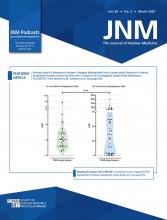TO THE EDITOR: We were greatly intrigued by the article titled “Fibroblast Activation Protein and Glycolysis in Lymphoma Diagnosis: Comparison of 68Ga-FAPI PET/CT and 18F-FDG PET/CT” by Chen et al. in The Journal of Nuclear Medicine (1). This article highlights the distinctive and well-established role of [18F]FDG PET/CT in the management of lymphoma patients for determining disease extent, prognosis, and treatment response as exemplified by the Deauville score. In lymphoma patients, the superiority of [18F]FDG over fibroblast activation protein inhibitor (FAPI)–based tracers, a new class of radiopharmaceuticals that have otherwise shown higher diagnostic performance than [18F]FDG in various oncologic settings (2), raises important questions.
The paper’s results are thought-provoking, particularly considering the crucial role of the tumor microenvironment in lymphoma survival and growth (3). Notably, there has already been significant uptake of FAPI-based agents targeting the tumor microenvironment in lymphoma (4). In the study by Chen et al. (1), immunohistochemistry analysis revealed significantly lower fibroblast activation protein expression cell densities than hexokinase 2 and glucose transporter 1 in most lymphoma subtypes (P < 0.001).
Although [18F]FDG PET/CT plays a pivotal role in lymphoma management, a gray zone exists in which its diagnostic performance declines, notably in cases of indolent lymphomas or those with low [18F]FDG avidity. It is intriguing to explore whether a FAPI-based radiotracer could complement or serve as an alternative to [18F]FDG for these specific lymphoma subtypes. However, Chen et al. (1) did not thoroughly address this aspect, mainly because of the limited number of patients with indolent or low-avidity lymphomas. Additionally, their patient population is highly heterogeneous, encompassing various histopathologic patterns and clinical settings for the examinations. To address this limitation, a prospective study with a homogeneous group of patients and a well-defined study design would be desirable.
Another crucial consideration is the evolving landscape of lymphoma treatment. The current standard of care is chemoimmunotherapy, with salvage high-dose chemotherapy and autologous stem cell transplantation serving as the second-line treatments for patients with relapsed or refractory lymphomas (5). However, only a few patients achieve a cure with this intensive approach, and its applicability is restricted by comorbidities and advanced age (6). Recent advancements in immunotherapy involve CD19 chimeric antigen receptor T cells, which are autologous T cells genetically reengineered and approved for the treatment of relapsed or refractory aggressive B-cell lymphomas (7). Nonetheless, despite the high efficacy of chimeric antigen receptor T-cell therapy, a significant number of patients do not respond or experience relapses (8). In this context, FAPI-based radiotracers could be explored in a theranostic context, addressing the molecular target with appropriately radiolabeled agents, similar to current practices in the treatment of neuroendocrine tumors and prostate cancer. However, the role of the FAPI agent in refractory lymphoma patients still remains unexplored.
In conclusion, there is still much to discover regarding the role of FAPI-based radiotracers in hematology. We eagerly await the availability of commercially accessible radiopharmaceuticals to explore the advantages and potential limitations of this class of agents in various clinical settings, laying the foundation for innovative cancer monitoring strategies.
Priscilla Guglielmo*, Laura Evangelista
*Veneto Institute of Oncology, Padua, Italy
E-mail: priscilla.guglielmo{at}iov.veneto.it
Footnotes
Published online Feb. 1, 2024.
- © 2024 by the Society of Nuclear Medicine and Molecular Imaging.
REFERENCES
- Received for publication October 25, 2023.
- Accepted for publication October 31, 2023.







